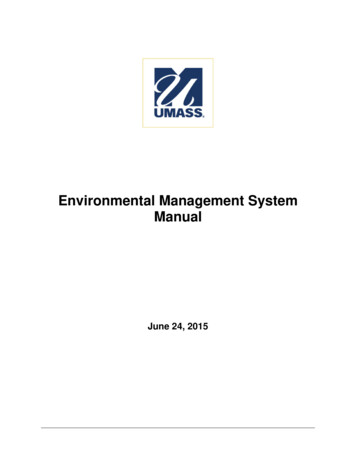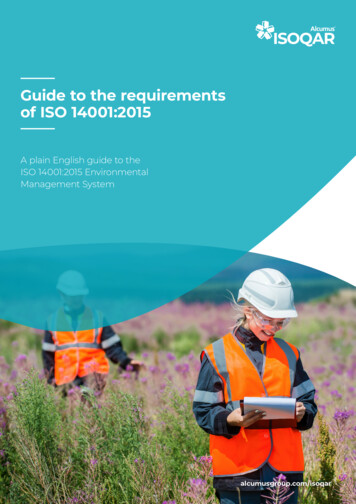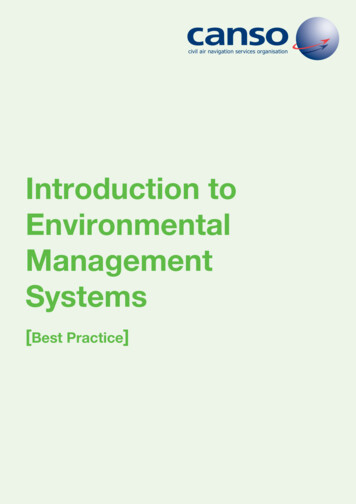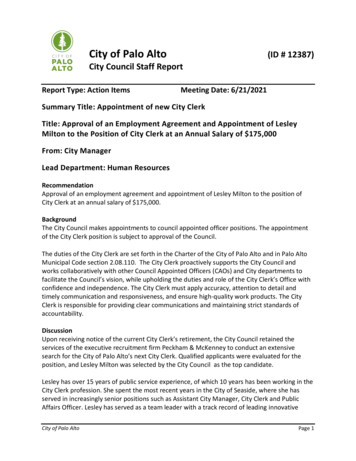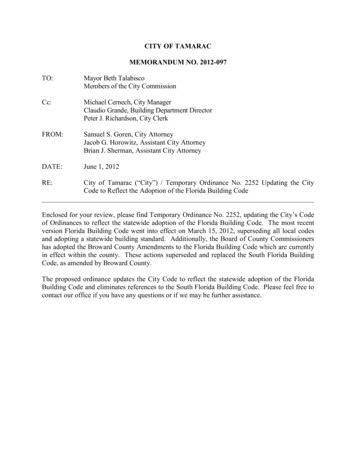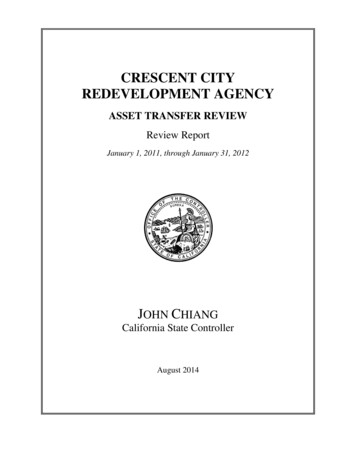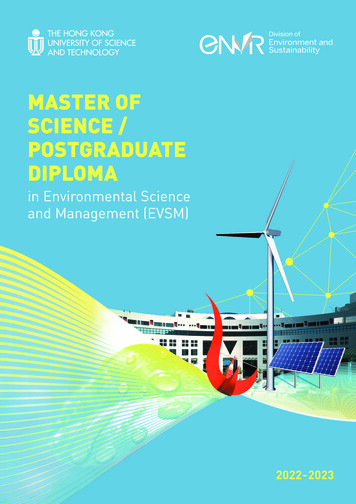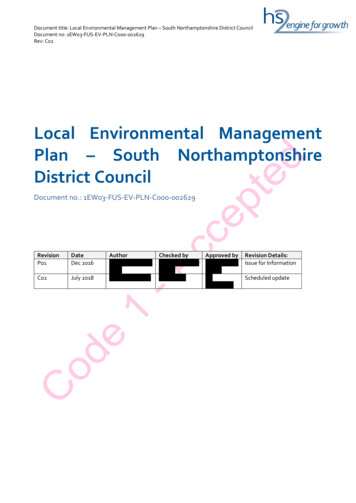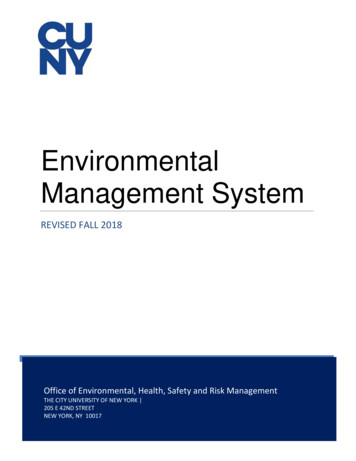
Transcription
EnvironmentalManagement SystemREVISED FALL 2018Office of Environmental, Health, Safety and Risk ManagementTHE CITY UNIVERSITY OF NEW YORK 205 E 42ND STREETNEW YORK, NY 10017
Table of ContentsINTRODUCTION .3ENVIRONMENTAL POLICY .4EMS SCOPE .5CAMPUS ADMINISTRATION AND OVERSIGHT .6ENVIRONMENTAL COMPLIANCE OBLIGATIONS.7ASSESSMENT AND PREVENTION .8ENVIRONMENTAL METRICS .11TRAINING.12DOCUMENTATION TRACKING .14CONTINUING PROGRAM EVALUATION AND IMPROVEMENT .16APPENDICES .17
The City University of New YorkStandard Operating ProcedureEnvironmental Management SystemRevised Fall 2018INTRODUCTIONBeginning in 2003, The City University of New York (CUNY) adopted an EnvironmentalManagement System (EMS) designed to support the effective management and continuedimprovement of its environmental programs. This EMS outlines monitoring objectives, regularreviews and revisions of key procedures to improve environmental performance.This manual describes the requirements and implementation of the EMS for all CUNYcampuses. It is not intended to supersede any specific operational rules or procedures thathave been adopted by the University to comply with health, safety and environmentalregulations or policies. The manual and related documents are available on-line at the Officeof Environmental, Health. Safety and Risk Management (EHSRM) websitehttp://www.cuny.edu/ehs.Please check the EHSRM website to be sure that you have the most recent version of themanual. In addition, we welcome your input and comments, so that we can continue toimprove the University’s environmental programs.Howard N. Apsan, Ph.D.University DirectorEnvironmental, Health, Safety and Risk Management3
The City University of New YorkStandard Operating ProcedureEnvironmental Management SystemRevised Fall 2018ENVIRONMENTAL POLICYThe City University of New York (CUNY) is committed to providing healthy and safefacilities for its students, faculty, employees and visitors. This includes minimizing impactson the environment, and maintaining compliance with applicable federal, state and localregulatory requirements, agreements and permits. The University’s approach to theenvironment integrates people, natural resources, and their interrelationships throughteaching and research activities, facilities operations and interactions with the community.This Environmental Management System (EMS) serves the University’s goals by incorporatingcomprehensive programs for compliance assurance, pollution prevention and training of faculty,employees and students. Implementation of this EMS includes undertaking continualimprovement, whereby the University will strive to enhance environmental performance byestablishing objectives and monitoring performance against these targets.4
The City University of New YorkStandard Operating ProcedureEnvironmental Management SystemRevised Fall 2018EMS SCOPEA. GeographicalThe scope of this EMS extends to all CUNY campuses, including the senior colleges,community colleges, professional schools, and any off-campus facilities or operations underCUNY jurisdiction.B. Regulatory Program AreasStand-alone health and safety concerns are typically not included in an EMS, except where thereis an overlap between environmental requirements and health and safety regulatory requirements.The EMS includes the following regulatory program areas:Environmental ConcernsRegulatory Program AreaHazardous Waste ManagementUniversal Waste ManagementWaste OilHazardous Waste and Materials TransportationCitation6 CRR-NY Parts 360-370Medical Waste10 CRR-NY Part 70Radioactive Waste6 CRR-NY Parts 380-3836 CRR-NY Parts 200-317Air EmissionsNOx EmissionsSOx EmissionsOzone Depleting ChemicalsParts WashersOffset Lithographic PressesAboveground Storage Tank ManagementUnderground Storage Tank Management6 CRR-NY Part 613Oil Storage and HandlingEmergency PlanningCommunity Right-to-KnowNYC Local Law 26 of 1988Security of Chemical Stock6 CFR Part 27Waste ManagementChemical Storage and HandlingSpill Prevention, Control, and Countermeasures Plan 40 CFR Part 112Water DischargesSilver Recovery SystemsRCNY 19-075
The City University of New YorkStandard Operating ProcedureEnvironmental Management SystemRevised Fall 2018CAMPUS ADMINISTRATION AND OVERSIGHTA. Defining OversightLeadership’s commitment to the CUNY Environmental Management System is key. Identifyingthose individuals responsible for specific roles at every campus ensures consistent implementationof the EMS. Oversight includes defined pathways for continual improvement. Each campus assignsroles and keeps up to date contact information for those responsible.B. AdministrationThe campus Environmental, Health and Safety Office (EHS Office) assists relevant offices, such asFacilities, Academic Affairs, and Public Safety, at each campus in implementing the EMSincluding training faculty, staff and students as required. The EMS results and feedback will beshared with EHSRM by the campus as detailed in this manual. The campus EHS Office willidentify any administrative officers who need to be involved in the processes.6
The City University of New YorkStandard Operating ProcedureEnvironmental Management SystemRevised Fall 2018ENVIRONMENTAL COMPLIANCE OBLIGATIONSA. Applicable ObligationsThere are numerous federal, state and local environmental requirements applicable to thevarious Regulatory Program Areas outlined in the EMS Scope. The University also reserves theright to adopt requirements that augment those required by law.B. Identification of Environmental RequirementsEHSRM maintains a list of applicable environmental requirements in a series of EnvironmentalRequirements Tables, which are attached as Appendix B. The list is updated on a regular basisand each campus is responsible for additional requirements specific to its obligations. See thesection regarding tracking environmental requirements regarding updates of this list.C. Assignment of Responsibility for Environmental RequirementsFor each environmental requirement, every campus will assign a person responsible to meetrequirements and complete or oversee tasks. These assignments will be noted on theappropriate form in Appendix C and submitted to EHSRM. Updates to assigned personnel willbe reported annually.D. Tracking of Environmental RequirementsChanging activities and operations at the University and on Campuses will change the applicableenvironmental requirements. Likewise, as new environmental regulations are adopted orpromulgated, the applicability and impact on University and Campus operations will alsochange. Campuses are expected to keep track of applicable requirements for their own programsand share these changes with EHSRM. The University is committed to tracking environmentalrequirements. Tracking environmental regulatory developments will be the responsibility ofEHSRM. It will determine whether any new or revised environmental requirements will requirechanges to training materials, policies and procedures or personnel responsibilities. EHSRM willwork with the Office of the General Counsel to interpret specific Environmental Requirementson an as needed basis.7
The City University of New YorkStandard Operating ProcedureEnvironmental Management SystemRevised Fall 2018ASSESSMENT AND PREVENTIONA. Assessment ScopeThe University has undertaken on-going mechanisms for assessing activities and operations andpreventing and controlling: (a) the release of hazardous waste or other pollutants into theenvironment; (b) threats to human health or the environment; or (c) violations of environmentalrequirements. These mechanisms take a life cycle approach to operation and support, frompoint of generation to disposal.B. ResponsibilitiesCampus EHS Officers are responsible for regularly conducting inspections and monitoringcorrective actions at their respective campuses. Each campus department is responsible forpromptly and fully responding to all EHS inspection findings and resulting corrective actions.EHSRM will conduct internal audits of each campus and provide written audit reports, asoutlined in the CUNY Internal Audit Program.C. Campus Inspection ProgramsCampus EHS Officers regularly conduct inspections of laboratories, mechanical rooms,classrooms, facilities areas and other campus areas where regulated activities occur. This includesmonitoring renovation and construction projects where appropriate. The campus EHS Office willmaintain an inspection schedule. The scope and frequency of these inspections varies dependingon the Regulatory Program Area involved, applicable environmental requirements and perceivedcompliance risk. Failure to establish and comply with the schedule will be considered a violationof this EMS.1. Inspections are to be carried out by trained personnel.2. Each EHS Office will keep a list of campus employees responsible for these inspections.The list must also include a trained backup person who can complete the inspection inthe absence of the designated employee. The supervisor responsible for employees, andthe manager or director responsible for that department should also be listed. Aresponsibility tracking sheet can be found in Appendix C and should be available andkept current.3. If any nonconformity identified during an inspection can be rectified by immediateaction (e.g., putting lids on containers, correcting labels, closing secondary containmentvalves, etc.), the inspector shall request that the problem be corrected at once. Such a8
The City University of New YorkStandard Operating ProcedureEnvironmental Management SystemRevised Fall 2018request shall be made to the Principal Investigator or to any other appropriate employee.If the inspection involves an area for which the inspector is responsible (e.g., SPCC orPBS inspections), the inspector may take corrective action.4. Inspectors will complete a written report detailing all nonconformities, apparent cause ofidentified problems and recommendations for specific corrective or preventive actions.The use of computer programs to assist with the process and report format are decisionsleft to the campus. Copies of these reports will be distributed to relevant departmentsand retained by the EHS Office. If the area inspected is a laboratory, a copy will also besent to the relevant Principle Investigator.5. The department or principal investigator is responsible for ensuring that identifiedcorrective and preventive actions are undertaken promptly and that notice of completionis sent to the EHS Office. If a problem cannot be rectified promptly, the EHS Office(and, if appropriate, the relevant principal investigator) will set a timetable forcompliance, which will be attached to the inspection report.6. Upon completion, the inspector will determine whether a re-inspection is required. Thedate for re-inspection shall be set and such information will be included in theinspection report.D. Internal Audit ProgramEHSRM audits each campus at least once every three years. Internal Audits cover all applicableenvironmental programs and focus on laboratories, mechanical rooms, classrooms, facilitiesareas and other areas where regulated activities occur. See the Internal Audit Program documentfor a detailed description of the audit process.1. Inspections are carried out by an audit team consisting of the UniversityEnvironmental Compliance Director, University Health & Safety Director, rotatingEHS Officers from campuses not being audited that semester, and other EHSRMsupport staff.2. EHSRM will complete a written report to describe the inspection findings, includingthe identification of problems, the applicable regulations and recommendations forspecific corrective or preventive actions, if any.3. After the audit report has been issued, the EHSRM auditors will meet with membersof the Campus Administration to discuss the audit report in detail including anysystematic changes recommended to maintain compliance.9
The City University of New YorkStandard Operating ProcedureEnvironmental Management SystemRevised Fall 2018E. Corrective ActionsThe University has committed to take all necessary corrective actions to address nonconformitywith environmental obligations, University policy and this EMS. It is also committed to investigatethe causes of such nonconformity and work with campuses to implement corrective and preventiveprocedures where necessary.1. Problems may be identified during a routine inspection, the Internal Audit Program, orduring an inspection by a regulatory agency. Regardless of the source, corrective actionsare required to eliminate the cause of nonconformity and prevent its recurrence.2. Corrective actions should be undertaken by the deadline agreed to by the interestedparties (e.g., an inspector or auditor and the campus EMS Representative) or required bythe specific agency. Failure to comply with applicable requirements in a timely mannerwill be considered a violation of this EMS.3. Internal Audits performed by EHSRM representatives include an audit findings reportprovided to the EHS Office and Campus Administration. In response, the Campus willprovide EHSRM with a detailed description of the corrective actions taken to mitigateeach deficiency within 14 days of receiving the audit report. If any corrective actionrequires more than 14 days to complete, the Campus will provide EHSRM with atimeframe for correcting the deficiency. If there is a time limit imposed by regulation, thetimeline provided by the Campus must comply. See the Internal Audit Program documentfor additional details.F. PreventionThe University is committed to continually improve its environmental compliance efforts and toprevent known problems from recurring.1. The EHS Officers from all campuses meet monthly and review any deficiencies orproblems found within the system including corrective measures employed to eliminatethe deficiencies.2. Checks for any new deficiency encountered will be added to the scope of the InternalAudit Program. Campuses shall also add checks for any new deficiency to appropriatereviews.10
The City University of New YorkStandard Operating ProcedureEnvironmental Management SystemRevised Fall 2018ENVIRONMENTAL METRICSA. ObjectivesThe University has undertaken implementation of a policy that prioritizes environmentalobjectives for the University and its Campuses. Performance evaluation and improvement isa part of these environmental objectives. EHSRM will look at indicators of performanceacross Regulatory Program Areas and work with campuses to use this data to improveenvironmental performance.B. Program1. Determination of Priority Issues. The University and Campuses help maintain andprioritize environmental issues at both the University and Campus levels.2. Use of Metrics. Targets and objectives to measure progress will be achieved through theuse of metrics where possible.3. Review of Specific Priorities. EHSRM and Campus EHS Officers evaluate metricsand, working with leadership, modify the metrics as necessary.4. Tracking Results. Each Campus tracks its progress towards specific goals.11
The City University of New YorkStandard Operating ProcedureEnvironmental Management SystemRevised Fall 2018TRAININGA. Program AreaThe Campuses provide mandatory environmental and safety training to all personnel thatrequire it in accordance with applicable regulatory requirements and as appropriate for theirposition. Personnel must be aware of Campus and University environmental policies andprocedures, the requirements of the EMS, and their roles and responsibilities. This includestraining. Failure to comply with applicable training requirements in a timely manner will beconsidered a violation of this policy.B. Training and Academic DepartmentsEnvironmental training of all relevant students, faculty and employees will be overseenby the campus’ EHS Office, even when appropriately outsourced, with the assistance ofEHSRM, as follows:1. Relevant students, faculty and employees (including temporary orvisiting personnel who will be working in a laboratory or engaging inregulated activities), and any others who require training, are referred tohere as Applicable Personnel or Applicable Person.2. Each department head will provide the EHS Officer with the followinginformation for each Applicable Person no more than five working days afterappointment, employment or enrollment:NameJob title/Student statusSupervisor, if anyWork locationStart dateJob duties/Student activities3. All Applicable Personnel will be required to take the basic courses madeavailable by the campus.4. The EHS Officer, in cooperation with department heads, will determine anyadvanced training Applicable Personnel require.12
The City University of New YorkStandard Operating ProcedureEnvironmental Management SystemRevised Fall 20185. In the event of extenuating circumstances, the five day period may beextended. The department head must provide the EHS Officer a date bywhich training will be complete in writing.6. Applicable Personnel may not continue to engage in regulated activities untilthey completed all required training.7. The EHS Office will schedule training classes in consultation with theaffected department heads. Campuses may work together to providetraining in cases where the numbers to be trained are low. Training may beprovided through classroom courses, web-based modules or outsourced toindustry accepted sources.8. The EHS Office will be responsible for maintaining allenvironmental training records. Including documentation ofcompetence for any outsourced training.9. An Applicable Person and their department will be considered in violationof this policy if they do not complete the required training.C. Training Records1. Class Records. The EHS Officer will keep the following records for each training classprovided:a. A copy of the course outline or presentation slides documenting course contentb. The sign-in or attendance sheetc. Copies of any tests given and the results2. Personnel Records. A record must be kept for each person and include a list ofrequired training, dates of successful completion and deadlines for required retraining. Current copies of any required certifications should also be kept withtraining files.13
The City University of New YorkStandard Operating ProcedureEnvironmental Management SystemRevised Fall 2018DOCUMENTATION TRACKINGA. ObjectiveThe University has undertaken a program to track environmental permits and otherdocumentation.B. Documents1. Campuses. Each campus will be responsible for making all environmental compliancedocuments available to EHSRM as part of the Internal Audit process. Documentsinclude, but are not limited to the following:a. NYC DEP combustion source registrationsb. NYC DEP VOC emission point registrationc. NYC DEP community right to know reports (receipts for electronicsubmission)d. NYS DEC air permits (Title V and state facility) or registrations and thecalculations used to determine permit statuse. NYS DEC air emissions discharge documentationi. Semi-annual SOx reportsii. Annual NOx reportsiii. Any other permit specific reports such as opacity or particulatesf. NYS DEC petroleum bulk storage registrations and:i. All correspondence regarding spills listed in the NYS DEC spills databaseii. Notification letters for removing a tank from serviceiii. Tank closure reports for removed tanksiv. Ninety day notification to the DEC prior to tank removalg. NYS DEC chemical bulk storage registrationsh. NYS DEC pesticide applicators reportsi. NYS DEC hazardous waste reportsj. US EPA notice of hazardous waste activityk. US EPA toxic release inventory (TRI) notificationl. Corrective action reportsm. All notices of violation and ensuing correspondencen. Regulatory incident investigation and remedial action reportso. Reports of campus EMS documentsi. Program Responsibility & Accountability Tracking Forms (Appendix C)ii. Environmental Metrics Trackingp. NYC DEP combustion source permits to construct14
The City University of New YorkStandard Operating ProcedureEnvironmental Management SystemRevised Fall 20182. EHSRM. CUNY EHSRM will generate and distribute the following documents:a. Compliance audit reports (Internal Audit Program)i. Executive summary of findingsii. Detailed list of findings, citations, and corrective actionsb. EHSRM EMS reportC. EMS Reports1. Initial EMS Report. An initial EMS report should be generated by the campus afterthe adoption of the EMS. This should detail the areas of environmental concernidentified by the University in this EMS and those specific to the Campus including adiscussion of baseline conditions and accompanying metrics.2. EHSRM EMS Report. A regular review of the EMS implementation that includes anevaluation of metrics, summary of Internal Audit reports and accounts of any outsideregulatory agency issues.D. Document Control1. This manual and the other written environmental policies, procedures, notices and otherdirectives will be stored electronically. Such documents may be revised only byEHSRM or persons designated by EHSRM.2. Records will be retained by the campus EHS Officer, as required by all relevant federal,state and local laws and regulations, by University policy or to the extent required byany investigation or litigation. The current applicable EMS Record Retention Policy isset forth in Appendix D.15
The City University of New YorkStandard Operating ProcedureEnvironmental Management SystemRevised Fall 2018CONTINUING PROGRAM EVALUATION AND IMPROVEMENTA. PurposeThe University has undertaken a program detailed in this EMS that includes a review ofimplementation and a commitment to continual improvement.B. Program1. Internal Audit -The Internal Audit conducted by EHSRM includes a section comparingthe audit results to those of previous audits. If deficiencies are repeated, the campuscorrective actions will require the inclusion of a plan to improve compliance.2. Annual EMS Reviews-A review of annual environmental metrics will be conducted.3. EHSRM EMS Reviews –EHSRM will address goals and targets via regular reviews.Special emphasis will be placed on activities and procedures designed to reduce the riskof non-compliance and prevent, reduce or minimize waste and emissions. Inestablishing goals and targets, consideration will be given to legal and regulatoryrequirements, technological options, financial, operational and business requirementsand views of interested parties.16
The City University of New YorkStandard Operating ProcedureEnvironmental Management SystemRevised Fall 2018APPENDICESA. Terms and DefinitionsB. Environmental Requirements TablesC. Program Responsibility & Accountability Tracking FormD. EMS Record Retention PolicyE. Compliance Calendar17
The City University of New YorkStandard Operating ProcedureEnvironmental Management SystemRevised Fall 2018APPENDIX ATERMS AND DEFINITIONSAcute Hazardous WasteAny hazardous waste with an EPA hazardous waste code beginning with the letter "P" (40 CFR261.33(e)) or any of the following "F" codes: F020, F021, F022, F023, F026, and F027 (40 CFR261.31). These wastes are subject to stringent quantity standards for accumulation and generation(40 CFR 261.5(e)).Air EmissionsAny physical, chemical, biological or radioactive substance or matter that is emitted into orotherwise enters the ambient air surrounding a property and contains air pollutants as defined inSection 302 of the Clean Air Act, as amended, 42 U.S.C, 7602.Applicable Personnel (also Applicable Person)Any individual (student, faculty or staff member within the CUNY system) whose work orassociation with certain materials or services necessitates that the individual be trained insubjects relevant to those materials or services to ensure the individual’s health and safety andthe health and safety of the environment.Asbestos-Containing Material (ACM)Any material that contains asbestos, a mineral fiber that can pollute air or water and cause canceror asbestosis when inhaled. EPA has banned or severely restricted the use of asbestos inmanufacturing and construction. All ACMs must be treated according to certain protocols referredto in this EMSCampusThe individual institutions that are a part of the CUNY system.Campus AdministrationThe administrative structure or structures of a campus that oversees facilities and academicoperations. These structures vary between campuses.Chemical StorageChemical storage procedures reduce health or physical hazards posed by chemical compoundsduring storage in the lab. Proper storage is designed to protect flammables from ignition,minimize the potential of exposure to poisons, and segregate incompatible compounds to preventtheir accidental mixing (via spills, residues, earthquakes, fires or human error).Chemical Tracking System (CTS)The CTS enable the University to track all the chemicals stored and used at the campuses, and tomanage the purchase, storage, use and disposal of chemicals safely and efficiently facilitating theUniversity’s ability to remain in compliance with regulations.18
The City University of New YorkStandard Operating ProcedureEnvironmental Management SystemRevised Fall 2018ComplianceAn affirmative indication or judgment that the supplier of a product or service has met therequirements of the relevant specifications, contract, or regulation; also the state of meeting therequirements.ConservationPreserving and renewing, when possible, human and natural resources. The use, protection andimprovement of natural resources according to principles that will ensure their highest economicor social benefits.Continual ImprovementProcess of enhancing the environmental management system to achieve improvements in overallenvironmental performance in line with the organization's environmental policy.Corrective ActionsAn action or measure taken to eliminate the causes of an existing nonconformity, defect, or otherundesirable situation in order to prevent recurrence.Due DiligenceThe goal of environmental due diligence is to identify potential areas of concern and to quantifythe costs and timeframe potentially needed for remediation. Due Diligence includesEnvironmental Site Assessments, Environmental Compliance Audits, and preparation ofenvironmental liability and compliance cost estimates.EHSRMThe University Office of Environmental, Health, Safety and Risk Management.Environmental Management System (EMS)A set of processes and practices that enable an organization to reduce its environmental impactsand increase its operating efficiency. An EMS is a continual cycle of planning, implementing,reviewing and improving the processes and actions that an organization undertakes to meet itsbusiness and environmental goals.Environmental Protection Agency (EPA)A federal agency created in 1970 that works for a cleaner, healthier environment for the UnitedStates of America. EPA leads the nation’s environmental science, research, education andassessment efforts by developing and enforcing regulations, performing environmental research,offering financial assistance, sponsoring voluntary partnerships and programs, publishinginformation and furthering environmental education.IndicatorAn indicator is a measurable representation of the condition or status of operations, management orconditions.19
The City University of New YorkStandard Operating ProcedureEnvironmental Management SystemRevised Fall 2018Internal Audit ProgramAn assessment conducted by CUNY employees of the current status of a party's compliance withapplicable environmental, health and safety requirements.Large Quantity GeneratorPerson or facility generating more than 2200 pounds of hazardous waste per month. Suchgenerators produce about 90 percent of the nation's hazardous waste, and are subject to allRCRA requirements.Life CycleLife cycle is the consecutive and interlinked stages of a product (or service) system, from rawmaterial acquisition or generation from natural resources to final disposal.ManualRefers to the most updated version of this CUNY Environmental Management System.Oil StorageAny containment vessel with a volume over 50 gallons.Pollution PreventionAny activity that reduces or eliminates pollutants prior to recycling, treatment, control or disposal.The underlying theory to this approach is that if one does not generate waste in the first place,there is nothing to treat or dispose of.Preventive ActionsUse of processes, practices, materials or products that avoid, reduce or control potentialproblems, such as recycling, treatment, process changes, control mechanisms, efficient use ofresources and material substitution to address pollution.Radiological MaterialsMaterials regulated un
Office of Environmental, Health, Safety and Risk Management THE CITY UNIVERSITY OF NEW YORK 205 E 42ND STREET NEW YORK, NY 10017 Environmental Management System REVISED FALL 2018 . See the Internal Audit Program document for a detailed description of the audit process. 1. Inspections are carried out by an audit team consisting of the University
